10 Critical Signs You Might Have Foundation Problems

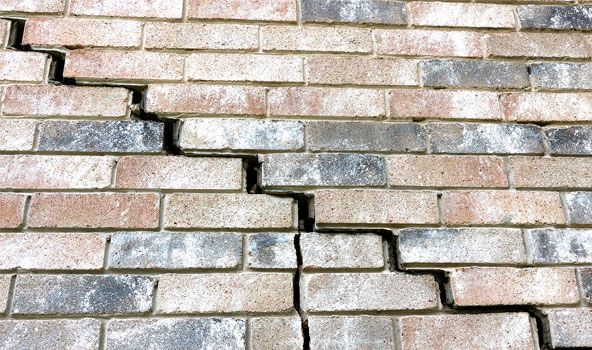
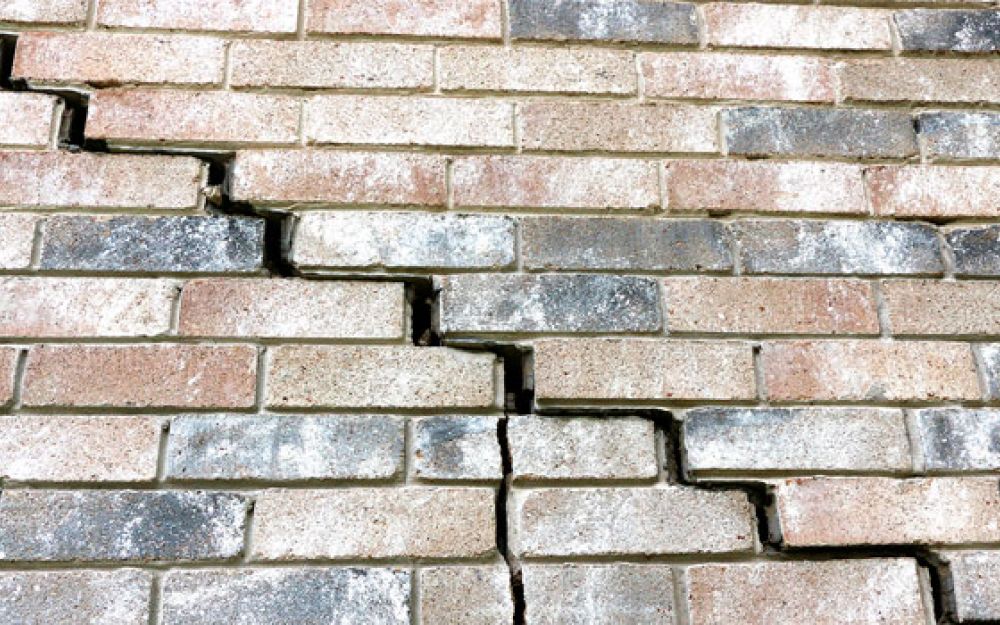
Experiencing Foundation Issues?
There are a lot of household problems that can be swept under the rug for “future you”. One set of problems that you don’t want to ignore, however, is foundation issues.
Foundation issues can ruin a house if left untreated, and they need to be addressed sooner rather than later. It’s best to identify them as soon as possible to save yourself a headache and a lot of money in the future.
Your home depends on the strength of your foundation. It supports the entire structure of your house, because it’s all connected. If there’s any weakness in the foundation, the damage will work its way up.
If you’re worried that you might be dealing with foundation issues now, or you want to be prepared for the future, don’t worry. Read on to learn about ten critical signs that you might be experiencing foundation issues in your home.
For professional help with foundation problems in the greater Hampton Roads, VA / NC region, learn more about BAY Crawl Space & Foundation Repair at our Home Page, About Us Page, or Request A Quote Page.
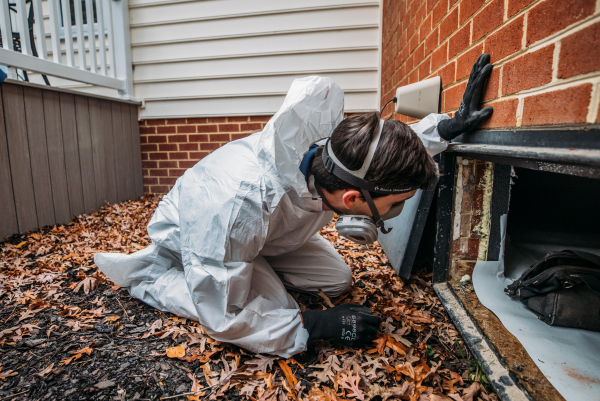
Guaranteed Solutions for Foundation Problems
- Crawl Space Moisture
- Crawl Space Mold
- Standing Water
- Musty Smells
- Sloping Uneven Floors
- Sticking Doors
- Cracked Bricks
- Drywall Cracks
- Crawl Space Wood Rot
- Foundation Settlement
- Basement Flooding
- Cold Floors
What Are Signs of Foundation Issues?
1. Cracked Drywall
If you have some walls with some diagonal cracks creeping up, you might be in trouble.
While a vertical crack might be normal, if you find yourself spotting more cracks form over time, it might be time to look into the foundation of your home.
Your floors are supported from the foundation upward, so if a crack has formed in the living space, then something is moving below. This is a clear sign that the foundation is not stable.
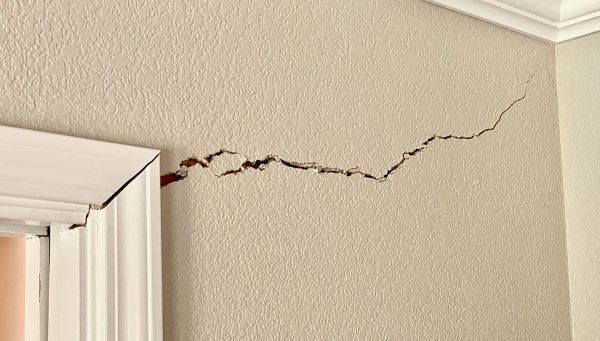
2. Gaps Between Exterior Windows and Walls
A shifting foundation can pull your walls away from your windows and doors.
This will likely happen very slowly, but it’s incredibly harmful over time. As the foundation pulls the walls away, the gaps can create room for moisture or bugs to get in. This can create more problems for the structure of the house.
If you notice this happening, call someone immediately to check out your foundation. A foundation stabilizer can help solve the problem.
3. You Notice a “Sinking” Feeling
If you’ve realized that one side of your building is lower than the other, or that your foundation appears to be “settling,” this is a problem.
Even a tiny dip that starts as only a few centimeters can grow to inches over time, so this is an issue that needs to be addressed quickly.
4. Counters, Cabinets, or Other Static Structures Separating From the Wall
If you notice that things that were once attached firmly to the wall now have small gaps in between them, look into the foundation.
If the floors and walls are no longer level in your home, this causes the things attached to the floors and walls to detach or crack in response. Even if you don’t notice the de-leveling, you can notice the detaching.
5. Cracked or Leaning Chimney
Excessive moisture or an unbalanced or unleveled foundation can lead to a chimney being cracked or broken, even completely crooked! Is it leaning? If it is, it could be a sign that your foundation is failing.
One of the best ways to tell if your chimney is leaning is by looking at its placement along the side of your home. If you notice space between the exterior of your house and the chimney, it is leaning.
A leaning chimney happens when your foundation sinks, raises, or shifts. Like with many other types of foundation issues, a leaning chimney can lead to water damage and mold if not fixed.
While this might not be something you recognize immediately if you start seeing other small signs, look to your chimney for confirmation.
6. Cracks in the Walls or Floor
Not all cracks are a cause for concern. Cracks happen in paint, or even in heavier materials. Hairline cracks can be easily fixed and are often cosmetic.
There are dangerous cracks though. If they’re horizontal or at a 45-degree angle, if they’re more than an eighth of an inch wide, or if they’re wider at one end than the other, it’s important to get them checked out.
These can be indicative of structural or foundational damage and can lead to larger cracks down the line if they’re not taken care of quickly.
7. Nails Popping Out of Drywall
Again, while this happening from time to time, or minimally, is totally okay, if it’s excessive you should look into it.
If you have a nail come out of the wall, it should be no big deal. Just hammer the nail back into the wall.
If all your nails are popping out of the wall, that is a sign of a problem. When the drywall in your home shifts, nails may move and come out of the wall. If you notice this happening, check for cracks on the inside and outside of your home.
8. Warped Floors or Ceilings
If your ceilings or floors sag down or warp up, it can show that your house is settling or your building is compressing. Beam issues happen when the foundation sinks, rises, shifts, or rots.
This is a bad sign of foundation issues, and it needs to be addressed. It’s more obvious in floors. While sometimes floors are built slightly off-level, if you notice a change, take note.
With concrete foundations, you may notice that your floor is uneven if the home has shifted. Whether you have a beam foundation or a concrete foundation, you will want to fix the damage immediately.
Uneven floors may seem like no big deal at first, but over time they can become dangerous. If children or elderly people are living in the home, they are more likely to trip on an uneven floor.
9. Musty Basement Smells
If your basement smells particularly musty or unpleasant, you might have a mildew problem.
Mildew happens because of moisture that’s getting in through tiny cracks in the foundation. Unfortunately, this means foundation problems.
Having too much moisture in your crawl space leads to beam rotting. If the foundation beams rot, you will have bigger and more expensive problems. Rotting beams often attract termites that get into the rest of your home.
Even if it doesn’t seem like your beams are rotting, you still should stop the moisture immediately. Moisture in homes leads to mold and mildew. Mold can cause skin irritation, sneezing, runny nose, and create a bad smell if not taken care of.
10. Unusual Walls
If your walls are doing things that they’re not supposed to be doing, it might be time to call in an expert. This can include a few things.
If they’re bowing in, this can be similar to the sagging floors and ceilings. There’s some compression happening and it needs to be adjusted before the problem gets worse.
Your walls can also begin pulling away from the house. If that happens, you run the risk of the whole thing coming down. To avoid this, call someone in immediately, don’t wait for more signs.
Spot Signs of Foundation Problems Before It’s Too Late
One of the best ways to prevent serious foundation problems is to try and spot them early. That’s why regular inspections and maintenance are essential. They will help you catch any minor foundation issues before they become major problems.
Of course, it’s important to know what to look for, so here are a few tips.
Use a Level and Check for Mold
Using a level to check for sloping or uneven floors is an excellent way to spot early signs of foundation issues. You should also keep an eye out for cracks in the walls or floors, doors, and windows that stick or don’t close properly. Check for water damage or mold growth as well.
Check the Drainage
Preventing foundation issues from happening in the first place is always preferable to dealing with repairs later on, so check your drainage. Proper drainage around your home can prevent water from seeping into the soil around the foundation and causing moisture problems.
Inspect Trees and Vegetation
Tree and vegetation management is vital, as the roots can push against your foundation and cause it to shift.
Check Gutters and Downspouts
Keeping your gutters clear and making sure the downspouts are properly directed away from your home can help prevent water damage.
Additional Signs of Foundation Issues
Cracks in the Tile
If you have tiles in your bathroom, kitchen, or any other part of your home, check to see if they are cracked. When tile floors are uneven or sink, the tiles may crack because they are fragile.
If you notice that tiles are cracking, have a foundation contractor access the situation. If you don’t fix the problem, you will need foundation repairs and tile repairs.
Doors Out of Alignment
Have you noticed that your doors are out of alignment? Are you having a difficult time opening and closing them? If so, foundation problems could be to blame. When your home’s foundation shifts, the doors may shift with it. If one side of the door is slightly higher than the other side, they will stick and you will have a hard time opening them.
While foundation problems are most like the cause of doors being out of alignment, the problem also could stem from high humidity. If you live in an area with high humidity and it has been raining for the past couple of days, wait until the rain stops to see if you still have the problem.
If the doors are still difficult to open, you should watch for other signs of foundation problems and have an expert check the doors.
Windows Don’t Work Properly
Like the doors, foundation damage affects the windows in a significant way. The movements in the foundation that lead to the changes in the position of walls may lead to windows leaving spaces beneath or above them when they lock. Always observe the ways your windows fit into the frames to know if there is any problem with cracks.
It is easier to notice changes in the way windows lock that doors. If they are always becoming loose when they lock, the frame is being forced to expand. There may also be cracks on the sides of the frames because the walls are moving.
Likewise, you may wake up one day and notice that your windows won’t lock or open even when the locks are not engaged. It is an effect of movements in the walls too. It would be best if you called an expert to check the foundation when you notice such situations.
Water Stagnates Near The Foundation
Have you noticed water stagnating and pooling around the foundation? This should worry you because it shows that your structure is experiencing a lot of damage. If the water used to flow freely even when it rains heavily, you have to check the foundation to make sure that nothing has changed.
Sometimes, foundations get destroyed, and this leaves a lot of depressions around them. They may also sink inwards and make the drainage systems less effective. When this happens, water will always stagnate around them, causing an unpleasant view in your home.
Even after water restoration, this water will keep pooling around these areas until the landscape is restored. You may notice that in some cases, the stagnating water causes even more damage to the foundation as it tends to drain into it.
Foundation Upheaval
The movement of slab foundation in the upward direction is termed as foundation upheaval. This is a key indicator of a problem with the structure of the foundation. Generally, foundation upheaval is caused due to the accumulation of excess moisture in the soil beneath it.
Heavy rains, broken pipes and lack of proper drainage provisioning results in the soil getting wet and heavy forcing the foundation upwards. Frost heave is another key factor that causes a considerable shift in the foundation. When water freezes it increases in volume by 9% putting adding pressure on the foundation which can result in the formation of cracks.
Keep Your Home Safe and Sound
Foundation problems can cause serious and costly issues for homeowners, but they can be prevented with regular maintenance and inspections. Knowing the first signs that you might have foundation problems and taking steps to prevent them can save you time and money in the long run.
If you think you’ve got foundation problems, don’t wait. Call the experts at BAY today and book a free inspection and quote at 757-460-0444.
How To Fix Foundation Issues?
If you’ve experienced one or several of these signs of foundation issues, it might be time to reach out to a professional for help.
Even if you’re unsure, it doesn’t hurt to get a professional opinion from someone who’s seen this before. If you need an expert, contact us for help. We can assess your home & stop future damages before it’s too late.
Why Choose BAY to Fix Your Foundation Issues?
BAY Crawl Space & Foundation Repair is your one-stop solution to fix foundation issues in Norfolk, Virginia, Suffolk, Newport News and the surrounding regions in VA & NC. Our expert teams have over 400 collective years of experience fixing homes in the Hampton Roads, Virginia & North Carolina service area.
Our staff includes engineering experts, foundation repair specialists, and a full support team ready to deliver exceptional customer service and a fast turnaround of your home foundation project. This is why BAY Crawl Space can offer a full warranty on installation and materials for your repair.
You can fix foundation issues today by taking advantage of our free crawl space and foundation inspection. This will identify any structural issues, foundation issues, or issues in the crawl space. Our expert advisors will then consult with the homeowner on their options to repair sagging, sloping, or uneven floors.
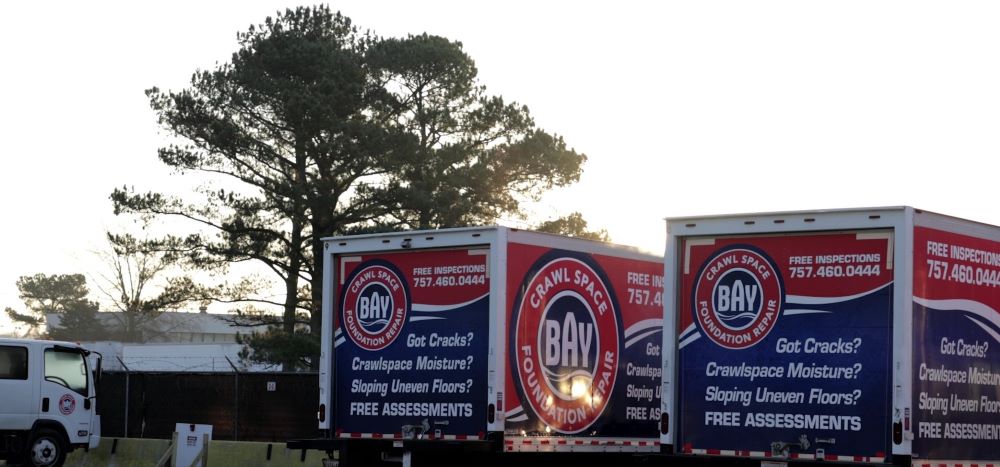
Full-Service Foundation Repair
At BAY Crawl Space and Foundation Repair, we offer all the services you need to protect your home from foundation damage while preventing mold and water damage. Learn more about the services we offer.
Foundation Crack Repair
Foundation cracks can be a severe problem leading to further damage if left untreated. These cracks can also allow water and pests to enter your home. Our team can repair any cracks in your foundation and ensure your structure is secure.
Foundation Jacks and Stabilizers
If your foundation is sinking or settling, we can install foundation jacks and stabilizers to provide the support it needs to remain stable. At BAY Crawl Space and Foundation Repair, we use innovative foundation jack systems to safely and permanently lift your home.
Basement & Crawl Space Repair
A damaged basement or crawl space can cause a host of problems, from mold and mildew to structural and water damage. Our team can repair any damage and ensure that your basement or crawl space is stable.
Crawl Space & Basement Waterproofing
If you’re experiencing water damage or moisture problems in your basement or crawl space, we can install a moisture control system to keep water out. This can include a sump pump system, vapor barrier, crawl space encapsulation, and more.
Mold Remediation
The water around your foundation can lead to both foundation damage and mold. We offer mold inspections, remediation, and cleanup to protect your home’s air quality and prevent respiratory illness.
Why Request a Free Foundation Inspection?
If you are a homeowner, it’s always a good idea to have your foundation inspected occasionally, even if you don’t notice any problems yet. At BAY Crawl Space and Foundation Repair, we proudly offer our clients FREE foundation inspections so they can protect their homes. See why a foundation inspection can be a smart choice.
Identify Any Issues Before They Get Worse
A free foundation inspection can help you find any issues with your home’s foundation, crawl space, or basement before they become more severe. Catching problems early can save you money on repair costs.
Reduce the Risk of Future Issues
Identifying and fixing problems early can reduce the risk of future issues. This can help protect your home’s structural integrity and ensure that it remains in good condition for years.
Create a Proactive Foundation Maintenance Plan
While you can’t plan for natural disasters such as earthquakes and floods, you can help prevent soil settling due to poor drainage or damage from tree roots. We can help ensure your foundation is well-maintained and fortified against the most common causes of foundation damage.
Save Money on Repair Costs
Repairing foundation, crawl space, or basement issues can be expensive. By catching problems early, you can save money on repair costs and avoid more significant issues that can be even more costly.
Protect Your Home from Structural Failure
A damaged foundation, crawl space, or basement can lead to structural failure in your home. By requesting a free foundation inspection, you can help to protect your home from this type of damage and ensure that it remains safe and structurally sound.

BAY Crawl Space & Foundation Repair Mini-BIO
BAY is an award-winning crawl space and foundation repair contractor. We’re proud to service an 80-mile radius around our Norfolk, VA headquarters, Monday to Friday, from 7 am to 5 pm, at 757-460-0444.
BAY is best known for having amazing reviews (quality & quantity), superior expertise, special methods, and affordable pricing options. We have the ‘Best of the Best’ on our team. Our All-Star Team delivers great customer experiences and the best quality for a great price.
Our reputation in the Hampton Roads community with homeowners, engineers, city permitting offices, home services professionals, and online as a crawl space foundation repair home service contractor is outstanding.
#1 Rated Locally for Foundation Repair
Our reviews show our commitment to taking great care of our customers over the years. We pride ourselves on giving great customer experiences & delivering excellent value. Our experience & efficiency allow us to do more, for less.
- Google – 4.9 Rating with 800+ Reviews
- Angi – 4.9 Rating with 300+ Reviews
- Facebook – 5.0 Rating with 300+ Reviews
- HomeAdvisor – 4.9 Rating with 200+ Reviews
- Better Business Bureau – 4.9 Rating with 300+ Reviews

